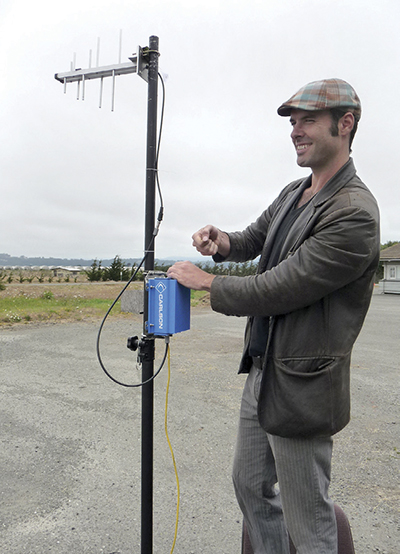‘White Space’ Use No Longer a Gray Area

West Virginia University student Niesha Shafer uses Wi-Fi on the university’s tram system, which includes a link on an unused TV channel.
ALEXANDRIA, VA.—Broadcasters worried about the effects of unlicensed broadband data devices operating between licensed TV channels—the so-called “white spaces”—need to know that these bits of spectrum are now being used.
One of the first operations to actually go live is called AIR. U, named after the Advanced Internet Regions consortium. On July 9, it fired up a system at West Virginia University in Morgantown, W.Va.
Calling itself “the first university in the U.S. to use vacant broadcast TV channels to provide the campus and nearby areas with wireless broadband Internet services,” AIR.U provides free public Wi-Fi access.
“AIR. U demonstrates the real potential of innovation and new technologies to deliver broadband coverage and capacity to rural areas and small towns to drive economic development and quality of life, and to compete with the rest of the world in the knowledge economy,” West Virginia University Chief Information Officer John Campbell said in a press release.
For the time being, AIR. U is being used to provide the final link to locations that it would otherwise be impractical for data access. One example is West Virginia University’s Public Rapid Transit, a 73-car tram system that transports more than 15,000 riders daily.
With the AIR. U system, a data link on an unused TV channel feeds a Wi-Fi router at each tram platform, which is then used to get Wi-Fi access on the moving trams.
Get the TV Tech Newsletter
The professional video industry's #1 source for news, trends and product and tech information. Sign up below.
The university just fired the system up and there’s been minimal use with the students out for summer break, but Campbell expects usage to dramatically increase when students return to campus.
He expects that the university and its partners will look at the system’s use and decide how to expand the system after gathering enough data.
Campbell added that the university doesn’t have a defined end date for the project, and are currently meeting to discuss additional potential projects. “Those projects will primarily focus on increasing wireless access for faculty, staff and students, as well as a potential project with the city,” he said.
The event did not go unnoticed by others who have an interest in using white space spectrum.
“The innovative WVU network demonstrates why it is critical that the FCC allows companies and communities to use vacant TV channel spectrum on an unlicensed basis,” said Michael Calabrese, director of the wireless future project at the Washington-based New America Foundation, which is affiliated with AIR. U.
AIR. U boasts a list of backers that include Google and Microsoft, as well as regional organizations such as the Appalachian Regional Commission, the New England Board of Higher Education and the Corporation for Education Network Initiatives in California. In announcements regarding the system at West Virginia University, the team members refer to the technology as “Super WiFi.”
FCC-APPROVED TESTS

Kiely Cronin of Carlson Wireless sets up one of the company’s outdoor client units. WRAL, the Raleigh, N.C. CBS affiliate, has teamed with Carlson Wireless Technologies in an FCC-sanctioned test of unlicensed white space technology this summer. Carlson Wireless is providing its RuralConnect base stations, and the project has been granted a Special Temporary Authority by the FCC.
For its part, Carlson Wireless is convinced that unlicensed white space devices can peacefully coexist with broadcasters.
“The regulations behind TVWS are designed to prevent interference,” said Kiely Cronin, TV white space product development manager for Carlson Wireless Technologies in Arcata, Calif. “TVWS radios, for instance, must operate through a database manager to acquire a list of available channels. In addition to that, the FCC has mandated strict emission requirements so that radios using designated channels don’t interfere outside of that space.”
Cronin stated emphatically that interference with licensed broadcasters is simply not going to happen. For the past half decade, the NAB has been working with the FCC to create the rules under which white space devices will work, and is not opposed to the rollout of white space data services and tests.
Specialists in DTV broadcasting are not so sure about the lack of interference, however.
“The available amount of white space spectrum will be significantly reduced if many DTV channels are taken away by the FCC for broadband wireless use, and many DTV stations remain on the air crammed into the remaining spectrum,” said Gary Sgrignoli, DTV transmission consultant and partner at Meintel, Sgrignoli, & Wallace in Mount Prospect, Ill. “Without even considering white space device interference, there is a real concern that after a spectrum repack the remaining DTV signals may interfere with one another if special care in RF channel allocations is not taken, as described so often by Charlie Rhodes in his TV Technology articles.”
Cindy Hutter Cavell, senior engineer at the consulting engineering firm of Manassas, Va.-based Cavell, Mertz & Associates, agrees.
“With the impending TV band repack, it remains to be seen as to how much white space will be available for any sort of device,” she said.
ROOM FOR DISAGREEMENT
When it comes to the possibility of interference with licensed DTV broadcasts, the experts find some room for disagreement.
Sgrignoli said that DTV-into-DTV interference from fixed transmitter sites with known frequencies and power levels is difficult enough by itself, but the problem is significantly increased when dealing with mobile devices like white space products that can be randomly placed in proximity to DTV receive antennas.
“Since the white space devices are frequency adaptive and low-power, it is unlikely that they will have any material impact on over-the-air reception,” Hutter Cavell said. “It is possible that these devices will have some effect on uncoordinated equipment such as wireless microphones and IFBs in broadcast venues, as well as in stadiums, auditoriums, churches and other entities that use wireless mics.”
Still, if interference does happen, finding the culprit won’t be easy.
“Determination of DTV interference from white space devices is certainly a concern for broadcasters,” Sgrignoli said. “This concern stems from the difficulty in measuring white space signals that are not constantly transmitting and that might be changing frequency and/or transmit power sporadically as needed. A typical spectrum analyzer will not do the job, and therefore specialized test equipment would be needed during a site evaluation by an engineer.”
Hutter Cavell pointed out that there is a published list of approved white space products, which can help stations understand what sort of devices might be the culprits. There is also a list of approved coordinators for such devices, although there are only two at the moment—a third is in final stages of approval. These frequency coordinators should be helpful in solving interference complaints.
PROMOTING HIGH-SPEED INTERNET
The demand for wireless Internet connectivity is insatiable, however, and pressure is coming from the highest levels of government to bring such spectrum online.
Commenting on the WVU network, West Virginia Senator Jay Rockefeller, chairman of the Senate Committee on Commerce, Science and Transportation, said, “I have made promoting high-speed Internet deployment throughout West Virginia, and around the nation, a priority. That is why I am excited by [the July] announcement of the new innovative wireless broadband initiative on West Virginia University’s campus. Wireless broadband is an important part of bringing the economic, educational, and social benefits of broadband to all Americans.”
Kiely Cronin of Carlson Wireless said that his company sees wireless broadband services in white space channels as a “disruptive technology,” one that can break through the technical barriers imposed by the current network of cable and fiber web connections. Riding the wave of that disruption is what Carlson Wireless hopes to do.
One thing in favor of unlicensed broadband data on white space frequencies is that it is likely to shy away from urban areas that have dense lineups of DTV stations. These areas are already well served with Internet service providers and they generally don’t need additional competition. In rural areas, there may be only a handful of TV broadcasters.
Cronin said that a Carlson Wireless base station can work with a client from as far away as 10 miles, although connecting within a one-mile radius is more typical.
“Right now, wireless broadband delivered using white space devices is primarily a rural solution, as rural areas have the best channel availability,” Cronin said. “However, as lower-powered mobile devices come to market, we should see increased urban applicability.”
Bob Kovacs is the former Technology Editor for TV Tech and editor of Government Video. He is a long-time video engineer and writer, who now works as a video producer for a government agency. In 2020, Kovacs won several awards as the editor and co-producer of the short film "Rendezvous."

